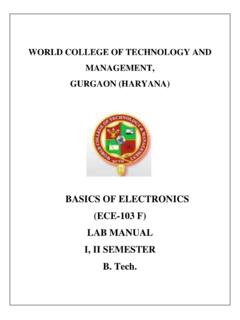Transcription of LAB MANUAL FOR OS LAB - World College of Technology and ...
1 WCTM /IT/LAB MANUAL /5TH SEM/OS LAB 1 OS LAB MANUAL LAB MANUAL FOR OS LAB WCTM /IT/LAB MANUAL /5TH SEM/OS LAB 2 OS LAB MANUAL operating System An operating Sytem is a program that manages the computer hardware. It also provides a basisfor application programs and acts as an intermediary between a user of a computer and the computer hardware. Goals of operating system : Execute user programs and make solving user problems easier. Make the computer system convenient to use. Use the computer hardware in an efficient manner. Computer System Components 1. Hardware provides basic computing resources (CPU, memory, I/O devices). 2. operating system controls and coordinates the use of the hardware among the various application programs for the various users. 3.
2 Applications programs define the ways in which the system resources are used to solve the computing problems of the users (compilers, database systems, video games, business programs). 4. Users (people, machines, other computers). Abstract View of System Components operating System Definitions 1. Resource allocator manages and allocates resources. 2. Control program controls the execution of user programs and operations of I/O devices . 3. Kernel the one program running at all times (all else being application programs). WCTM /IT/LAB MANUAL /5TH SEM/OS LAB 3 OS LAB MANUAL Windows 2000 The Microsoft Windows 2000 operating system is a 326bit preemptive multitasking operating system for Intel Pentium & later microprocessors. Key goals for the system: o Portability o security o POSIX compliance o multiprocessor support o extensibility o international support o compatibility with MS6 DOS and MS6 Windows applications.
3 Uses a micro6kernel architecture. Available in four versions, Professional, Server, Advanced Server, National Server. In 1996, more NT server licenses were sold than UNIX licenses History In 1988, Microsoft decided to develop a new Technology (NT) portable operating system that supported both the OS/2 and POSIX APIs. Originally, NT was supposed to use the OS/2 API as its native environment but during development NT was changed to use the Win32 API, reflecting the popularity of Windows Design Principles Extensibility layered architecture. o Executive, which runs in protected mode, provides the basic system services. o On top of the executive, several server subsystems operate in user mode. o Modular structure allows additional environmental subsystems to be added without affecting the executive. Portability 2000 can be moved from on hardware architecture to another with relatively few changes. o Written in C and C++. o Processor6dependent code is isolated in a dynamic link library (DLL) called the hardware abstraction layer (HAL).
4 Reliability 2000 uses hardware protection for virtual memory, and software protection mechanisms for operating system resources. Compatibility applications that follow the IEEE (POSIX) standard can be complied to run on 2000 without changing the source code. WCTM /IT/LAB MANUAL /5TH SEM/OS LAB 4 OS LAB MANUAL Performance 2000 subsystems can communicate with one another via high6performance message passing. o Preemption of low priority threads enables the system to respond quickly to external events. o Designed for symmetrical multiprocessing International support supports different locales via the national language support (NLS) API. Windows 2000 Architecture The architecture of Windows 2000 is Layered system of modules. The main layers are the HAL, kernel, executive all of which run in protected mode, and a large collection of subsystem that run in protected mode.
5 User mode collection of subsystems. The two categories : Environmental subsystems emulate different operating systems ; Protection subsystems provide security functions. WCTM /IT/LAB MANUAL /5TH SEM/OS LAB 5 OS LAB MANUAL System Components Kernel The kernel of Windows 2000 provides the foundation for the executive and the Kernel is never paged out of memory; execution is never preempted. It has four main responsibilities: Thread scheduling Interrupt and exception handling Low6level processor synchronization Recovery after a power failure The Kernel is object6oriented. An Object type in Windows 2000 is a system defined data type that has a set of attributes and a set of methods. The uses two sets of objects. Dispatcher objects control dispatching and synchronization (events, mutants, mutexes, semaphores, threads and timers). Control objects (asynchronous procedure calls, interrupts, power notify, power status, process and profile objects.)
6 1. Kernel Process & Threads : The Kernel process has a virtual memory address space, information (such as a base priority), and an affinity for one or more processors. Kernel threads are the unit of execution scheduled by the kernel s dispatcher. Each thread has its own state, including a priority, processor affinity, and accounting information. A thread can be one of six states: ready, standby, running, waiting , transition,and terminated. 2. Kernel Scheduling The dispatcher uses a 326level priority scheme to determine the order of thread execution. Priorities are divided into two The real6time class contains threads with priorities ranging from 16 to 31. The variable class contains threads having priorities from 0 to 15. The Characteristics of 2000 s priority strategy is Trends to give very good response times to interactive threads that are using the mouse and windows , Enables I/O6bound threads to keep the I/O devices busy , Complete6bound threads soak up the spare CPU cycles in the background.
7 Scheduling can occur when a thread enters the ready or wait state, when a thread terminates, or when an application changes a thread s priority or processor affinity. Real6time threads are given preferential access to the CPU; but 2000 does not guarantee that a real6time thread will start to execute within any particular time limit. (This is known as soft realtime.) 3 Kernel Trap Handling The kernel provides trap handling when exceptions and interrupts are generated by hardware of that cannot be handled by the trap handler are handled by the kernel's exception dispatcher. WCTM /IT/LAB MANUAL /5TH SEM/OS LAB 6 OS LAB MANUAL The interrupt dispatcher in the kernel handles interrupts by calling either an interrupt service routine (such as in a device driver) or an internal kernel routine. The kernel uses spin locks that reside in global memory to achieve multiprocessor mutual exclusion.
8 Executive 1. Object Manager Windows 2000 uses objects for all its services and entities; the object manger supervises the use of all the objects. Generates an object handle, Checks security. Keeps track of which processes are using each object. Objects are manipulated by a standard set of methods, namely create, open, close, delete, query name, parse and security. The Windows 2000 executive allows any object to be given a name, which may be either permanent or names are structured like file path names in MS6 DOS and implements a symbolic link object, which is similar to symbolic links in UNIX that allow multiple nicknames or aliases to refer to the same process gets an object handle by creating an object by opening an existing one, by receiving a duplicated handle from another process, or by inheriting a handle from a parent object is protected by an access control list. 2. Virtual Memory Manager The Virtual memory portion of Windows 2000 executive is the virtual memory design of the VM manager assumes that the underlying hardware supports virtual to physical mapping a paging mechanism, transparent cache coherence on multiprocessor systems, and virtual addressing aliasing.
9 The VM manager in 2000 uses a page6based management scheme with a page size of 4 KB. The 2000 VM manager uses a two step process to allocate memory : The first step reserves a portion of the process s address space. The second step commits the allocation by assigning space in the 2000 paging file. The virtual address translation in 2000 uses several data structures. Each process has a page directory that contains 1024 page directory entries of size 4 bytes. Each page directory entry points to a page table which contains 1024 page table entries (PTEs) of size 4 bytes. Each PTE points to a 4 KB page frame in physical memory. A 106bit integer can represent all the values form 0 to 1023, therefore, can select any entry in the page directory, or in a page table. This property is used when translating a virtual address pointer to a bye address in physical memory. A page can be in one of six states: valid, zeroed, free standby, modified and bad. WCTM /IT/LAB MANUAL /5TH SEM/OS LAB 7 OS LAB MANUAL Virtual-Memory Layout Virtual-to-Physical Address Translation 10 bits for page directory entry, 20 bits for page table entry, and 12 bits for byte offset in page.
10 3. Process Manager Provides services for creating, deleting, and using threads and processes. Issues such as parent/child relationships or process hierarchies are left to the particular environmental subsystem that owns the process. 4. Local Procedure Call Facility The LPC passes requests and results between client and server processes within a single particular, it is used to request services from the various 2000 a LPC channel is created, one of three types of message passing techniques must be specified. First type is suitable for small messages, up to 256 bytes; port's message queue is used as intermediate storage, and the messages are copied from one process to the other. Second type avoids copying large messages by pointing to a shared memory section object created for the channel. Third method, called quick LPC was used by graphical display portions of the Win32 subsystem. WCTM /IT/LAB MANUAL /5TH SEM/OS LAB 8 OS LAB MANUAL 5.




